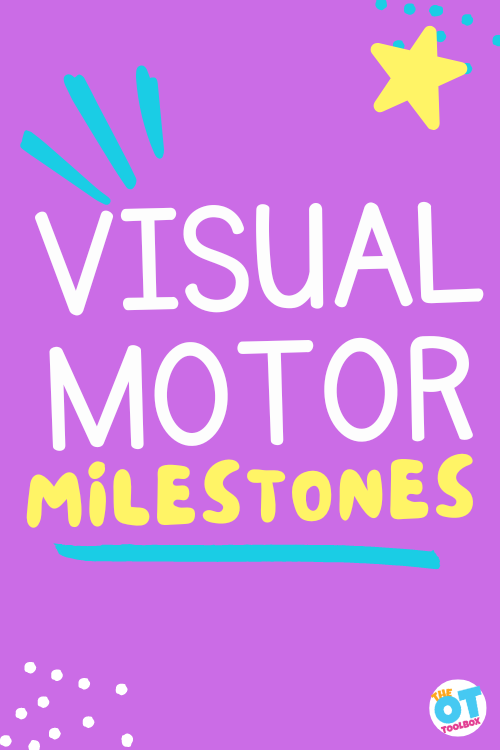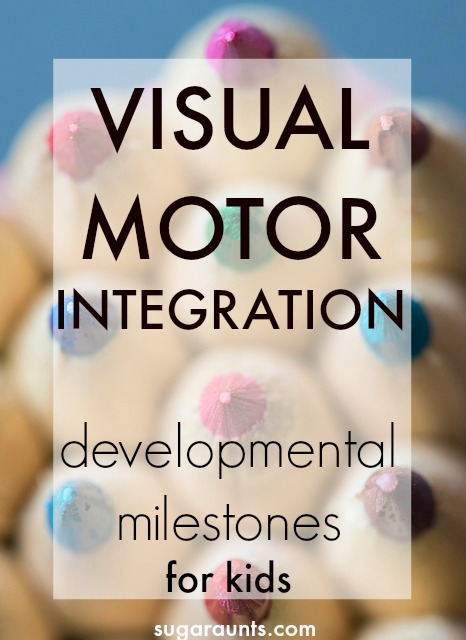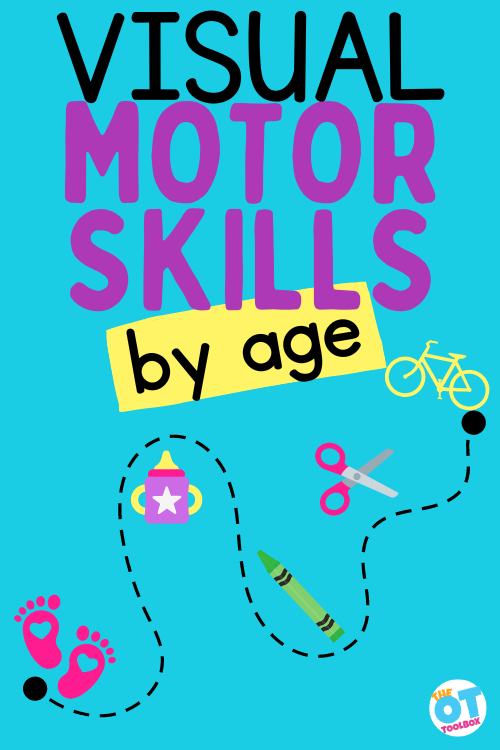This resource includes visual motor skills by age and lists visual motor integration developmental milestones. Visual motor development is part of hand eye coordination skills that happen from a very young age. From shaking a rattle and reaching for baby toys, to holding a pencil and writing letters, the developmental milestones are something to guide functional skill achievement! Let’s explore these visual motor developmental milestones!

As an Amazon Influencer, I earn from qualifying purchases.
Visual Motor Skills by Age
If you’ve followed along with us here at The OT Toolbox, then you know that I love to pull my background as an occupational therapist into posts. The crafts and activities that we do are more than just fun and cute. There are important skills that a child develops through play.
Visual Motor Skills are needed for many functional tasks like handwriting and pencil use, scissor use clothing management, and many more tasks.
How does Visual Motor Integration develop in kids? We put together this list of developmental milestones for a general idea of development and so parents can tell when a problem might be present.
It is important to note that every child is different and every child develops differently. These milestones are organized by developmental stages. Be sure to contact your pediatrician for medical advice. If occupational therapy is needed to assist with delays in visual motor integration, an assessment from a licensed occupational therapist is necessary to determine individual needs and treatment.
This hand eye coordination activities for toddlers post has more ideas.
What is visual motor integration?
Visual motor integration is often times presented a Hand eye coordination. It is the ability to use your hands and eyes together in a coordinated manner.
However, visual motor integration has some difference: The visual perceptual skills that are necessary for the visual component of visual motor skills play a major part in perceiving and interpreting visual information.
With skill achievement comes greater precision and finger dexterity, as well as the motor planning needed in order to accomplish more difficult tasks.
Visual motor development is needed for many functional tasks:
- Shake a rattle
- Reach for toys
- Bring toys to the mouth
- Reach for a face when held (babies)
- Pick up food from a high chair tray
- Reach for a bottle or cup to the mouth and putting it back down
- Releasing objects or toys (babies dropping things from their high chair continuously and love seeing someone older pick it up and put it back so that they can drop it again reinforces this skill)
- Coloring with crayons- progression of coloring skills happens with age along the milestone achievement
- Scribbling
- Playing with toys- shape sorters, puzzles, cause and effect toys, etc.
- Holding a pencil and drawing shapes, forming letters- This level of visual processing is necessary for copying forms and identifying inconsistencies in written work. It plays a part in letter reversals and letter formation.
- Cutting with scissors
- Navigating stairs
- Throw a ball
- Catch a ball
- Pouring and scooping
- Using utensils- progression from spoon, to fork, to knife- Check out this resource on how to hold a spoon and fork for specifics.
- Riding a bike
- So many more tasks that require visual motor skills!
In eye-hand coordination specifically, the eyes and hands work together to move the pencil, catch a ball, thread beads on a pipe cleaner, or other tasks that require the eyes and hands to fluently coordinate in actions.
You can see how, with development of both the eyes and motor skill dexterity and strength of the hands, feet, core, and legs allows for progression of skills.
The visual component and the motor skills begin working together at a very young age and continue to develop in efficiency as a child grows. This is visual motor development!


Developmental Milestones for Visual Motor Integration
These visual motor developmental milestones are listed by age of typical development, however, these are general guidelines of development. There can be many other considerations impacting skill achievement. If a child hasn’t achieved a skill by the dates listed below, it’s not a huge issue. It could be that the path to skill progression is varied, and that’s ok!
If you have questions about these milestone skills and dates, especially if it seems there are many skills that aren’t being achieved within months of the dates listed below, it may be beneficial to seek out input and individualized evaluation from a pediatric occupational therapy professional.
Resources may include our parent toolbox, getting started with OT, and what you need to know about child development.
ONE MONTH:
- Tracking a rattle while lying on back
- Tracking a rattle to the side
TWO MONTHS:
- Infant regards their own hands
- Tracks a ball side to side as it rolls across a table left to right and right to left
- Tracks a rattle while lying on back side to side
THREE MONTHS:
- Extends hands to reach for a rattle/toy while lying on back
FOUR MONTHS:
- Reaches to midline for a rattle/toy while lying on back
- While lying on back, the infant touches both hands together.
SIX MONTHS:
- Brings hands together to grasp a block/toy while sitting supported on an adult’s lap
- Extends arm to reach up for a toy while laying on back
SEVEN MONTHS:
- Transfers a block/toy from one hand to the other while sitting supported on an adult’s lap.
- Touches a cereal piece with index finger
- Bangs a toy on a table surface while sitting supported on an adult’s lap
NINE MONTHS:
- Claps hands together
TEN MONTHS:
- Removes loose pegs from a Peg Board
ELEVEN MONTHS:
- Removes socks
- Releases a cereal bit onto table surface
- Places blocks into a cup. Developmental progression of block skills involves more visual motor skill achievement as well.
TWELVE MONTHS:
- Turns pages in a board book
- Imitates stirring a spoon in a cup
THIRTEEN MONTHS:
- Imitates tapping a spoon on a cup
- Begins to places large puzzle pieces in a (Amazon affiliate link) beginner puzzle (affiliate link)
FOURTEEN MONTHS:
- Scribbles on paper
SIXTEEN MONTHS:
- Imitates building a tower of 2-3 blocks (affiliate link)
NINETEEN-TWENTY MONTHS:
- Builds a block tower, stacking 4-5 blocks (affiliate link)
TWENTY THREE-TWENTY FOUR MONTHS:
- Imitates copying vertical lines (read about pre-writing line skills)
TWENTY FIVE-TWENTY SIX MONTHS:
- Removes a screw top lid on a bottle
- Stacks 8 blocks (affiliate link)
- Begins to snip with scissors
TWENTY SEVEN-TWENTY EIGHT MONTHS:
- Imitates horizontal strokes with a marker
- Strings 2 Beads (affiliate link) (read about fine motor skills with beads for more ideas to support this development)
- Imitates folding a piece of paper (bending the paper and making a crease, not aligning the edges)
TWENTY NINE MONTHS:
- Imitates building a train with blocks
- Strings 3-4 Beads (affiliate link)
- Stacks 10 blocks (affiliate link)
THIRTY ONE MONTHS:
- Builds a “bridge” with three blocks (affiliate link)
THIRTY THREE MONTHS:
- Copies a circle
THRITY FIVE MONTHS:
- Builds a “wall” with four blocks (affiliate link)
THIRTY SEVEN MONTHS:
- Cuts a paper in half with scissors
FOURTY MONTHS:
- Lace 2-3 holes with string on Lacing Shapes (affiliate link) (Read about lacing cards and fine motor skills)
- Copies a cross
FOURTY TWO MONTHS:
- Cuts within 1/2 inch of a straight line
- Traces a horizontal line
FIFTY MONTHS:
- Copies a square
- Cuts a circle within 1/2 inch of the line
- Build “steps” with blocks (affiliate link)
FIFTY FOUR MONTHS:
- Connects two dots to make a horizontal line
- Cuts a square within 1/2 inch of the line
- Builds a “pyramid” with blocks (affiliate link)
FIFTY FIVE MONTHS:
- Folds a piece of paper in half with the edges parallel
- Colors within lines

Activities to help develop visual motor integration
When it comes to play, visual motor integration is part of every play activity. Some informative resources that include the sensory motor integration of visual input and motor output include the underlying skills that are all related.
These specific activities will support visual motor skills and visual motor skills play a pivotal role in these areas:
- Crossing midline activities
- Bilateral coordination activities
- Crossing midline activities for preschoolers
- Vision activities
- Motor planning activities
- Fine motor skills
- Gross motor skills
Developmental milestone achievement in children occurs through play. Use these play ideas to get you started on building skills:
- Coloring – Read about the benefits of coloring in supporting visual motor skill progression.
- Playing with stickers- Playing with stickers supports many developmental skills.
- Drawing
- Occupational therapy toys
- Tracing activities- Read about when and why to use tracing activities
- Playing with a ball
- Sports
- Building with blocks
- Puzzles
- Board games
- Cause and effect toys
Some more of our favorite OT activities for supporting development of visual motor skills includes:
Blue-Themed Sensory Play for Babies and Toddlers
Fine Motor Play with Tissue Paper
Tracing Letters: Letter Formation Handwriting Practice with Chalk
Tracing Lines with a DIY Light Box
Pencil Control Worksheets You Can Make At Home
Christmas-Themed Pencil Control Activities-DIY Worksheets for Pencil Control
Scissor Skills: Activities for Kids
Improving Scissor Skills with Play Dough
Using Stickers to Help with Scissor Skills
Finger-painting Fireworks for Scissor Use
Icicle Winter Scissor Skills Activity
Bunny Tongs Scissor Skills Activity
Color Sorting Scissor Activity
Use the fine motor kits to support development of visual motor skills and visual perception development through hands-on, play-based activities:
Working on fine motor skills, visual perception, visual motor skills, sensory tolerance, handwriting, or scissor skills? Our Fine Motor Kits cover all of these areas and more.
Check out the seasonal Fine Motor Kits that kids love:






Or, grab one of our themed Fine Motor Kits to target skills with fun themes:
- Frogs Fine Motor Kit
- Unicorns Fine Motor Kit
- Vehicles Fine Motor Kit
- Apple Fine Motor Kit
- Back to School Kit
- Sports Fine Motor Kit
- Outer Space Fine Motor Kit
- Fairytale Fine Motor Kit
- Plus more in our shop!
Want access to all of these kits…and more being added each month? Join The OT Toolbox Member’s Club!






